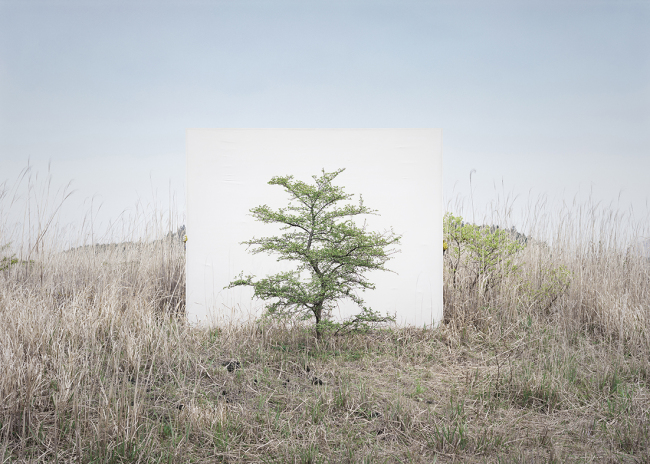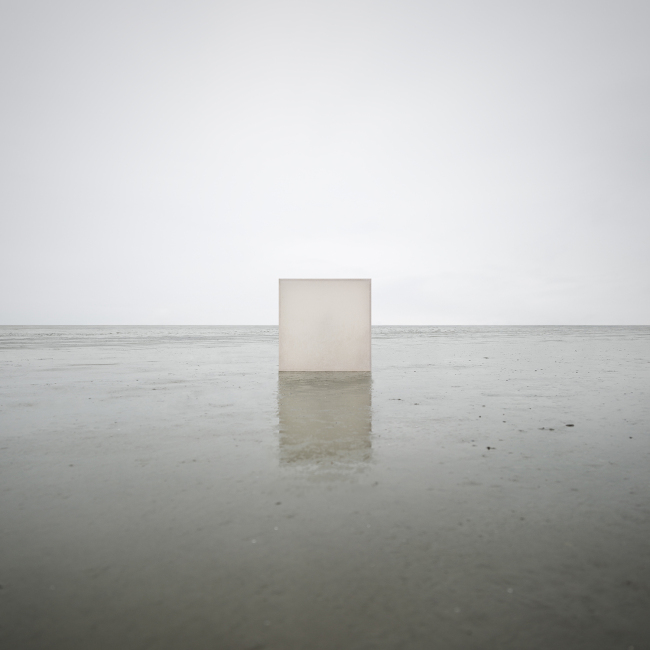A tree stands against the backdrop of a large white canvas. The artist‘s intervention with the canvas creates a portrait of a tree. Standing out of nowhere, the tree in front of the white backdrop also appears as an alien installation to the landscape. The highlighting of the tree as an object changes the scene.
Gallery Hyundai is holding a solo exhibition of works by phtographer Lee Myung-ho, introducing his latest series titled “Nothing But,” as well as work from his past series, “Tree” and “Mirage.”
 |
Photographer Lee Myung-ho’s 2017 work “Tree ... #9” (Gallery Hyundai) |
Lee first earned international recognition through his solo exhibition at Yossi Milo Gallery last year with his “Tree” series.
In his “Tree” series, a large-sized white canvas creates a backdrop to a tree in each photo, clearly defining how each bough breaks, as well as the crisp details of the leaves. The canvas also isolates the tree from its immediate surroundings, and the framed tree gets the spotlight.
The white canvas is Lee‘s otherworldly addition to a landscape. In the middle of a landscape which otherwise would have no particular focal point, he theatricalizes his “objet.”
What viewers see is a staged object and the surrounding scene, as well as the mise-en-scene of landscape that has been elevated. Here, Lee suggests another method of representation, as well as another way to look at the object and its nearby terrain.
The process of taking the photograph is similar to that of set staging. A group of people work with cranes, ropes and pipes to make the canvas stand upright behind a tree.
If his “Tree” series used the white canvas to allow the viewers to more actively engage with the represented objects, and their corporeal qualities, his two other series use canvases in different ways.
 |
Photographer Lee Myung-ho’s 2009 work “Mirage #1, Gobi Desert” (Gallery Hyundai) |
The atmosphere that Lee’s creates in his 2009 photography taken at the Gobi Desert is a “Mirage.” For the photo project, Lee connected a number of canvases to span about one kilometer. The photo, taken from a distance, however, shows no trace of the curtain of canvases but creates an illusion instead. In the “Mirage” series, no particular object is highlighted but only a visual effect that envelops the landscapes.
Lee’s photos continue to be non-referential through his latest “Nothing But” series. This series is similar to his previous “Tree” series, except that there is no object in front of the white canvas. Lee’s blank white canvas stands in natural landscapes.
 |
Photographer Lee Myung-ho’s 2018 work “Nothing But #2” (Gallery Hyundai) |
“Nothing But” could also be anything, Lee explained. By erasing objects or intentionally hiding objects behind the white canvas, Lee attempts to break away from the conventional ties between the real and the represented. There is no particular reference. Representation, which has been the most important function of the camera since its birth, loses its significance. The photographer does not decide what to show but asks the viewers to choose what to see.
“9 Minutes Layers” is another work of photography that erases its object. For the work, he took a total of 10 photos of the same object for nine minutes -- each taken a minute apart from the other.another. Lee, then, juxtaposed them into a single image, using computer software. The result is a pure white square printed on a sheet of paper with slightly different states of white.
 |
Photographer Lee Myung-ho’s 2018 work “Nothing But #3” (Gallery Hyundai) |
Lee’s solo exhibition will run through Jan. 6, 2019 at Gallery Hyundai.
By Shim Woo-hyun (
ws@heraldcorp.com)











